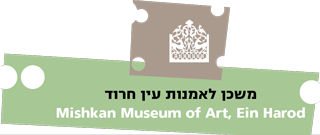
Gabriela Schutz paints massive housing complexes consisting of units spread out across the landscape and laid out in a repetitive manner. The hallucinatory character of the paintings stems from the way the image floats upon the paper or canvas background, like a bubble or a shrouded vista that brings back a distant echo, a pictorial memory of views of the Holy Land that were painted by pilgrims. This painterly device of an image that “fades” at its margins was common among landscape painters of the previous centuries who sought the floating “sight”, a means of elevating the picture of the landscape from the ground of a gray, concrete reality. Yet these controlled and “classical” paintings created by Schutz (who studied under the painter Rachel Shavit before beginning her formal studies at the Bezalel Academy) leads the eye, with a seemingly eternal multiplicity of detail, to an inevitable collision. The romantic, idyllic promise is not fulfilled, and not only because of the massively built character of the landscape: the shroud of whiteness is not “mountain air as clear as wine”, but the indifferent background of a screen; the point of departure is not a view of “nature”, and the “source” is a media image mediated and disseminated by digital means. Schutz’s complete mastery of the aestheticism of paintings from the past enables her to charge and to juxtapose a pictorial memory with a new critical context that overturns a world of concepts, gives presence to an illusion, preserves the astonishment and the seductive wink the sight of a mirage might evoke. The picture of the present evokes echoes of a place and a time and instantaneously awakens an ironic, acerbic, inquisitive ars-poetical complexity. “Holyland”, the title of these paintings by Gabriela Schutz, is not exactly “the Holy Land”: it is the name of a housing project in south Jerusalem, a Golem or monster that has turned upon its creator, Orly Castel-Bloom’s Dolly City.
In another group of paintings, the picture plane is covered with a grid like those that were characteristic of modern minimalist painting. Visible through the mesh of lines, across the entire breadth of the paper or the canvas, is a Palestinian landscape. The grid turns out to be not merely a stylistic marker: it also carries the meaning of a security fence – and the point of view is from behind the fence of the West Bank settlement Emmanuel. One of the paintings in this group, which belongs to the “Like, Comment, Share” series, was painted from Facebook. Its point of departure is an image that appeared as a “post”, which Schutz copied and posted again on Facebook as an image. She asked her readers to help her, and when she received responses she added the “likes” and the comments to the painting. “The Facebook works,” she says, “relate to our desire to incessantly document our lives and to receive lots and lots of feedbacks saying we are liked. Facebook is a kind of reality program where we’re constantly checking what’s new there, but the posts disappear from our minds the moment they vanish from our eyes”. Gabriela Schutz’s paintings dance with the phantom of a dystopian all-embracing image that erases intimacy, memory and the richness of language – and her paintings, with their small and modest steps, encapsulate contexts, durations, complexities of gaze and fabrics of life.
Gabriela Schutz was born in Israel in 1971, studied with Rachel Shavit from 1998 through 1991, graduated from the Bezalel Academy of Art, Jerusalem in 1996. She lives in London.
[Translator’s note:] The opening line of “Jerusalem of Gold” by Naomi Shemer. Written after the Six-Day War of 1967, the song quickly became immensely popular in Israel.
Gabriela Schutz
Holyland
Curator: Galia Bar Or
November 2013-January 2014





